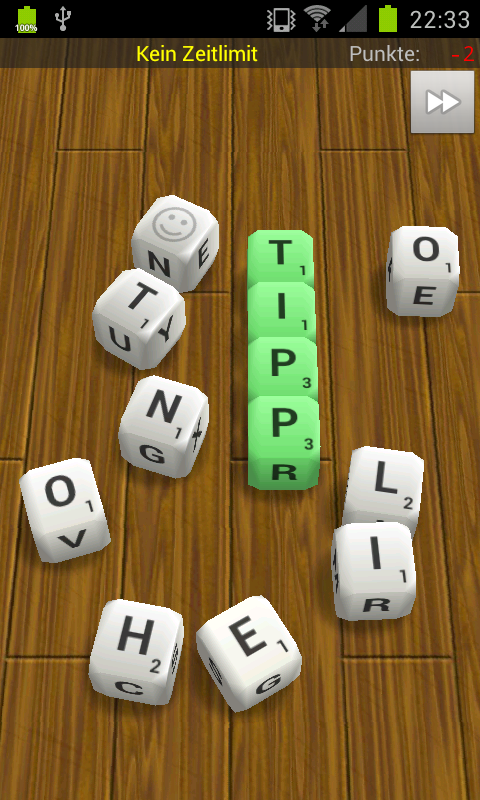I recently updated the Google Play Game Services library of Freebloks 3D for Android and the BaseGameUtils, as recommended by Google. Not reading the ChangeLog, I was confused that my game tried to auto log in to Google on the start, disrupting the user experience I built around that. Even after dismissing the login dialog once would show the dialog again in the next Activity that is derived from BaseGameActivity or uses a GameHelper object.
Searching the Interwebs I found the FAQ, which explained the change of behaviour, and I am sad that the game itself once again becomes more and more insignificant:
The default behavior of BaseGameActivity and GameHelper is to show the user the sign-in flow (consent dialogs, etc) as soon as your application starts. Naturally, once the user signs in for the first time, they won’t see the consent flow again, so it will be a seamless experience. […]
The first time a game is started, the user will be prompted with a full screen dialog asking the user for consent to post on their behalf to Google+. The user hasn’t seen anything of my App yet and still Google tries to put itself into the foreground. After the user signed in, this might become a seamless experience but being prompted with this dialog does not seem like a good experience. Especially because there is no warning or explanation of what this dialog does.
It is important for the user to sign in as early as possible so your application can take advantage of the Google Play Games API right away (for example, saving the user’s progress using Cloud Save, unlocking achievements, etc).
I noticed that usually I want to explore the game a little before signing in to Google. I’d like to find out if the game is a game I’d continue to play and once I get engaged with a game, I am willing to sign in to use the additional features. I know I am not an everyday user and I am aware that logging in to Google gives up some privacy. And before I haven’t decided to continue playing a game, I do not want any information to leak or social activity to be generated.
Obviously this reads to me as:
it’s important for the developers and Google to get user generated activity and data as soon as possible.
And is again another step towards games telling the users what to do.
If the user cancels the sign-in flow, BaseGameAcitivity/GameHelper will remember that cancellation. If the total number of cancellations reaches a predefined maximum (by default, 3), the user will no longer be prompted to sign in on application startup. If that happens, they can still sign in by clicking your application’s Sign In button, if you provide one.
Is not signing in to Google not a choice anymore but an error? If I dismiss the dialog because I do not give consent, is that assumed to be an error? Do I have to be prompted again even though I made the choice to not log in? Do I really have to dismiss the dialog 3 times until the game believes me that I do not want to log in?
The games are taking over!
I noticed the trend of games beginning to control users, of being needy, wanting attention, and developers seeing games only as a way to generate a stream of content or resources back to the developer.
Games these days:
- show popup notifications that they want to be played.
- make the user attend the game by long running tasks in the background that finish whenever. Building a building may take 5 hours, after which I have to open the game again.
- want you to share everything on Facebook or Google+ (“Your creature took a dump. Share on Facebook?”). This is not to make you happy or to provide a game element, it is purely to attract other people and make them install the game.
- tell you exactly and in detail how to use it. A lot of games begin with a 10 minute intro (“now click here”, “now buy upgrade”, “now shoot”) to make sure that the user understands the concept of buying upgrades and in game currency. This leaves very little room for experimentation and explorations, because users need to follow the strict predefined path that generates revenue.
- lock you in. Using In-App-Purchases basically makes you rent the game, it is like Prepaid and the decision to stop playing a game is harder, because you have money that will expire. When you buy a game and own it, you have the freedom of choice to not play it. Buying your right to play the game over and over will most likely leave you hanging in an awkward spot when you decide to stop. Oddly enough these games are advertise as Free or Free2Play or, less often, Pay2Win.
- use gamification to seem more interesting. Most games implement achievements in a way, so that they are not game elements. The Google Play services offer achievements that are outside of the game, meaning they don’t change the game flow, giving the user no actual value of an earned achievement. While the wording suggests the user benefits from earning an achievement, this is likely to drive engagement with the game but will not result in higher user experience or even fun. I fear the day users wonder about the motivation to achieve anything.
- artificially restrict themselves but still take over your time. Why does building a house takes 5 hours sometimes, while the game does not any other game elements during that time? I’s making me hooked, telling me to go on with my day but of course I will always have the game on my mind and I have to come back after 5 hours. The game dictates when the user can play with it and when he can’t. It is not the users decision anymore to play and spend time with the game.
Where did the games go that gave power and freedom to the players to do what they want to do? With room to explore? With having game elements to actually fill 5 hours of time, then waiting and being ready when I come back to it? Where did the love go to provide the user with a fun way to pass his time?
This is not about the user anymore. He is not the customer, he is the good to be sold, the “conversion” to be made. The game is just the means and additional game elements are in the way. Games became a pure medium for developers and Google to say to users: “Give me your money”.
Where was I? Oh yes, disable the auto-login.
Easy enough the above behaviour can be reverted by
getGameHelper().setMaxAutoSignInAttempts(0);
but that’s not the point. Give the power back to the user!
























